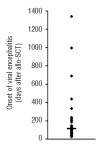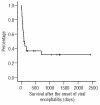Viral encephalitis after allogeneic stem cell transplantation: a rare complication with distinct characteristics of different causative agents
- PMID: 20851868
- PMCID: PMC3012778
- DOI: 10.3324/haematol.2010.029876
Viral encephalitis after allogeneic stem cell transplantation: a rare complication with distinct characteristics of different causative agents
Abstract
Background: Limited data are available on characteristics of viral encephalitis in patients after allogeneic stem cell transplantation.
Design and methods: We analyzed 2,628 patients after allogeneic stem cell transplantation to identify risk factors and characteristics of viral encephalitis.
Results: Viral encephalitis occurred in 32 patients (1.2%, 95% confidence interval 0.8%-1.6%) and was associated with the use of OKT-3 or alemtuzumab for T-cell depletion (P < 0.001) and an increased mortality (P = 0.011) in comparison to patients without viral encephalitis. Detected viruses included human herpesvirus-6 (28%), Epstein-Barr virus (19%), herpes simplex virus (13%), JC virus (9%), varicella zoster virus (6%), cytomegalovirus (6%) and adenovirus (3%). More than one virus was identified in 16% of the patients. The median onset time was 106 days after allogeneic stem cell transplantation for the total group of 32 patients, but onset times were shortest in those with human herpesvirus-6 encephalitis and longest in those with JC virus-associated progressive multifocal leukoencephalopathy. The probability of a sustained response to treatment was 63% (95% confidence interval 44%-82%) with a median survival of 94 (95% confidence interval 36-152) days after onset, but significant variation was found when considering different causative viruses. Patients with herpes simplex virus encephalitis had the most favorable outcome with no encephalitis-related deaths.
Conclusions: The use of OKT-3 or alemtuzumab for in vivo T-cell depletion is associated with an increased risk of viral encephalitis after allogeneic stem cell transplantation. Different viruses are frequently associated with distinct characteristics such as onset time, response to treatment and outcome.
Figures
References
-
- Antonini G, Ceschin V, Morino S, Fiorelli M, Gragnani F, Mengarelli A, et al. Early neurologic complications following allogeneic bone marrow transplant for leukemia: a prospective study. Neurology. 1998;50(5):1441–5. - PubMed
-
- Sostak P, Padovan CS, Yousry TA, Ledderose G, Kolb HJ, Straube A. Prospective evaluation of neurological complications after allogeneic bone marrow transplantation. Neurology. 2003;60 (5):842–8. - PubMed
-
- Graus F, Saiz A, Sierra J, Arbaiza D, Rovira M, Carreras E, et al. Neurologic complications of autologous and allogeneic bone marrow transplantation in patients with leukemia: a comparative study. Neurology. 1996;46(9):1004–9. - PubMed
-
- Denier C, Bourhis JH, Lacroix C, Koscielny S, Bosq J, Sigal R, et al. Spectrum and prognosis of neurologic complications after hematopoietic transplantation. Neurology. 2006;67(11):1990–7. - PubMed
-
- Maschke M, Dietrich U, Prumbaum M, Kastrup O, Turowski B, Schaefer UW, et al. Opportunistic CNS infection after bone marrow transplantation. Bone Marrow Transplant. 1999;23(11):1167–76. - PubMed
MeSH terms
Substances
LinkOut - more resources
Full Text Sources




